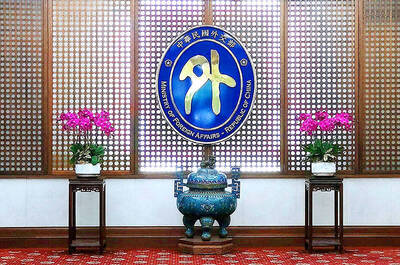A Taiwanese researcher says global positioning systems (GPS) are susceptible to interference from thunderstorms and so should not be relied upon in extreme weather conditions.
Lin Chien-hung (林建宏), an assistant professor at the Plasma and Space Sciences Center of National Cheng Kung University, said the strong atmospheric convections in a thunderstorm can create atmospheric oscillations -- tides -- that rise between 90km and 120km above ground, just under the ionosphere.
ATMOSPHERIC TIDES
Ions from the tides accumulate at that level and could interfere with electromagnetic waves, he said.
When transmission of electromagnetic waves is impeded, Lin said, signals from GPS satellites to GPS devices on the ground will be distorted, causing a phenomenon dubbed "GPS confusion,"in which the device gives inaccurate directions.
"Some of my friends told me stories of using a GPS device in thunderstorms," Lin said.
GETTING LOST
"They hoped the device could lead them out of the mountains despite the heavy rains. But even though they followed the directions given by GPS devices, they found themselves in the middle of nowhere," Lin said.
He said such stories have inspired him to do more research on the interaction of atmospheric convections and GPS devices.
Using the data collected by FORMOSAT-3, a climate satellite launched and operated by the government-funded National Space Organization and its US partners, Lin analyzed atmospheric variations during thunderstorms and observed how atmospheric tides created disruptions in electromagnetic waves.
ANOMALIES
Based on the data gathered by an IMAGE satellite in 2002, the US National Aeronautics and Space Administration has listed four areas as "equatorial regions with anomalies in ionospheric activities."
These regions are: the Amazon valley, the Congo River valley, Indonesia's rain forests and the middle of the Pacific Ocean, where most tropical storms form, he said.
"Taiwan is in the mid-Pacific region, where a thunderstorm near the ground will disturb the upper atmosphere and could impact the functions of a GPS device," Lin said.

The Ministry of Foreign Affairs (MOFA) yesterday voiced dissatisfaction with the Comprehensive and Progressive Agreement for Trans- Pacific Partnership (CPTPP), whose latest meeting, concluded earlier the same day, appeared not to address the country’s application. In a statement, MOFA said the CPTPP commission had "once again failed to fairly process Taiwan’s application," attributing the inaction to the bloc’s "succumbing to political pressure," without elaborating. Taiwan submitted its CPTPP application under the name "Separate Customs Territory of Taiwan, Penghu, Kinmen and Matsu" on Sept. 22, 2021 -- less than a week after China

THE GOOD WORD: More than 100 colleges on both sides of the Pacific will work together to bring students to Taiwan so they can learn Mandarin where it is spoken A total of 102 universities from Taiwan and the US are collaborating in a push to promote Taiwan as the first-choice place to learn Mandarin, with seven Mandarin learning centers stood up in the US to train and support teachers, the Foundation for International Cooperation in Higher Education of Taiwan (FICHET) said. At the annual convention of the American Council on the Teaching of Foreign Languages held over the weekend in New Orleans, Louisiana, a Taiwan Pavilion was jointly run by 17 representative teams from the FICHET, the Overseas Community Affairs Council, the Steering Committee for the Test of Proficiency-Huayu, the

A home-style restaurant opened by a Taiwanese woman in Quezon City in Metro Manila has been featured in the first-ever Michelin Guide honoring exceptional restaurants in the Philippines. The restaurant, Fong Wei Wu (豐味屋), was one of 74 eateries to receive a “Michelin Selected” honor in the guide, while one restaurant received two Michelin stars, eight received one star and 25 were awarded a “Bib Gourmand.” The guide, which was limited to restaurants in Metro Manila and Cebu, was published on Oct. 30. In an interview, Feng Wei Wu’s owner and chef, Linda, said that as a restaurateur in her 60s, receiving an

MORE RETALIATION: China would adopt a long-term pressure strategy to prevent other countries or future prime ministers following in Sanae Takaichi’s steps, an academic said Taiwan should maintain communications with Japan, as Japanese Prime Minister Sanae Takaichi is to lead a revision of security documents, Taiwanese academics said yesterday. Tensions have risen between Japan and China over remarks by Takaichi earlier this month that the use of force against Taiwan would constitute a “survival-threatening situation” for Japan. Prospect Foundation president Lai I-chung (賴怡忠) yesterday said Takaichi’s stance regarding Taiwan is the same as past Japanese prime ministers, but her position is clearer than that of her predecessors Fumio Kishida and Shigeru Ishiba. Although Japan views a “Taiwan contingency” as a “survival-threatening situation,” which would allow its military to